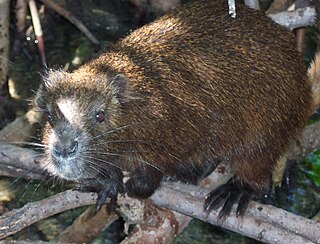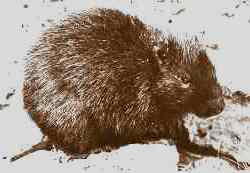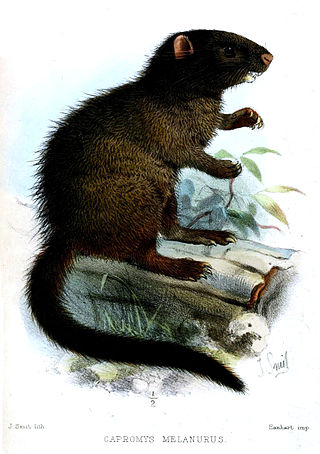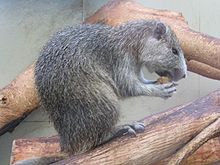
Hutias are moderately large cavy-like rodents of the subfamily Capromyinae that inhabit the Caribbean islands. Most species are restricted to Cuba, but species are known from all of the Greater Antilles, as well as The Bahamas and (formerly) Little Swan Island off of Honduras.
The dwarf hutia is a small, critically endangered, rat-like mammal known only from Cuba. Aside from tracks, it was last seen in 1937 and may be extinct. It gives birth to only a single offspring at a time, and is threatened by habitat loss and non-native species such as rats and mongoose. The dwarf hutia belongs to the hutia subfamily (Capromyinae), a group of rodents native to the Caribbean that are mostly endangered or extinct.
Garrido's hutia is a small, critically endangered, rat-like mammal found in coastal mangrove forests on Cuba and nearby islands. It is rarely seen and may be extinct. It is a member of the hutia subfamily (Capromyinae), a group of rodents native to the Caribbean that are mostly endangered or extinct. The only other species in its genus, the Desmarest's hutia, is also found only on Cuba.

Geocapromys is a genus of rodent belonging to the hutia subfamily and are currently only found on the Bahamas and Jamaica. However, they formerly ranged throughout the Caribbean, from Cuba to the Cayman Islands to even islands off mainland Central America.

Desmarest's hutia or the Cuban hutia is a stout, furry, rat-like mammal found only on Cuba and nearby islands. Growing to about 60 cm (2 ft), it normally lives in pairs and feeds on leaves, fruit, bark and sometimes small animals. It is the largest living hutia, a group of rodents native to the Caribbean that are mostly endangered or extinct. Desmarest's hutia remains widespread throughout its range, though one subspecies native to the nearby Cayman Islands went extinct shortly after European colonization in the 1500s.

The Cuban boa, also known as the Cuban tree boa and by locals as Majá de Santa María, is a very large species of snake in the family Boidae. With lengths exceeding 5 m (16 ft) and a relatively heavy build, the Cuban boa is one of the largest snakes in North America. The species is native to Cuba and some nearby islands. No subspecies are currently recognized.

Cabrera's hutia is a small, critically endangered, rat-like mammal found only in Cuba. It lives in communal shelters in swamps and coastal mangrove forests, and is threatened by habitat loss. It is a member of the hutia subfamily (Capromyinae), a group of rodents native to the Caribbean that are mostly endangered or extinct.

Mesocapromys is a genus of rodent in the subfamily Capromyinae. The genus is restricted to Cuba and associated islands.

The black-tailed hutia, also known as the bushy-tailed hutia, is a small, furry, rat-like mammal found only in Cuba. It lives in lowland moist forests and is threatened by habitat loss. It is a member of the hutia subfamily (Capromyinae), a group of rodents native to the Caribbean that are mostly endangered or extinct.
The Isla De La Juventud tree hutia or southern hutia is a subspecies of rodent in the subfamily Capromyinae. It is endemic to lowland moist forests on Isla de la Juventud in Cuba. It is threatened by habitat loss and is considered Critically Endangered by the IUCN Red List.

The prehensile-tailed hutia is a small, furry, rat-like mammal found only in forests on Cuba. It is the only member of the genus Mysateles. It climbs and lives in trees where it eats only leaves, and it is threatened by habitat loss. The prehensile-tailed hutia is a member of the hutia subfamily (Capromyinae), a group of rodents native to the Caribbean that are mostly endangered or extinct.

The San Felipe hutia, also known as the little earth hutia, is small, critically endangered, rat-like mammal found on the small island of Cayo de Juan Garcia off the southwest coast of Cuba. It was discovered in 1970 and is possibly extinct. Little is known about the species, except that it lives in swamps and coastal mangrove forests. It is a member of the hutia subfamily (Capromyinae), a group of stout rodents native to the Caribbean that are mostly endangered or extinct.

The Cuban dry forests are a tropical dry forest ecoregion that occupies 65,800 km2 (25,400 sq mi) on Cuba and Isla de la Juventud. The ecoregion receives 1,000–2,000 mm (39–79 in) of rainfall annually. Cuban dry forests can be differentiated into evergreen forests, semi-deciduous forests, mogotes, and sclerophyllous low forests.
The Archipiélago de Sabana hutia is a subspecies of the Desmarest's hutia endemic to the Sabana-Camagüey Archipelago of Cuba.
Hyperplagiodontia, rarely called the wide-toothed hutia, is an extinct genus of hutia which contains a single species, Hyperplagiodontia araeum. The species was originally described as a member of the genus Plagiodontia along with the extant Hispaniolan hutia, but after morphometric analysis in 2012, was moved to its own genus, Hyperplagiodontia. Fossils of H. araeum have only been found on Hispaniola, in the Dominican Republic and Haiti.









